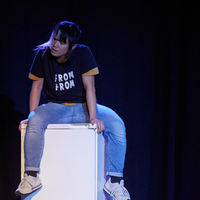Fri 26 Jan: Sunhi Willa Keller, Tarantism and Vittorio Pagani

News Story
Sunhi Willa Keller9 Tales of a Bitch
TarantismPanopticon
Vittorio Pagani Hinterlands - How to Look the Part
Pink handheld fans and quick feet shuffle on stage, alongside giggles and shy glances. Three performers fill the space where East meets West: Asian folk movements seamlessly intertwined with Western contemporary dance. “She’s such a bitch”, they tell us over and over as they dance. Provocation becomes resignation when the coy, alluring individuals transform into a single body of cleverly disguised female rage, moving as one. 9 Tales of a Bitch draws on the Kumiho myth, the nine-tailed fox, the famed shapeshifter and temptress. With a powerful statement on the female lived experience, Sunhi Willa Keller exposes the frustration behind the impossible patriarchal balancing act placed upon women: to be innocent yet seductive, and then be blamed for being either.
Hinterlands – How to Look the Part is a mixed-media playground of speech, dance, and video/audio projections. Portraying the problems that younger generations face nowadays, this three-act performance juxtaposes an existentialist feeling of (and literal) suffocation with moments of soft surrender, alternating between the intimate and impersonal. Act 1 hints at the pressure of having to find who you are. Act 2 shows us that even when you do, it may not be good enough for a society whose rules we did not dictate. Act 3 is a eulogy. In this work, Vittorio Pagani has the courage to be unfiltered as he guides us through what it is like while “the world is ending”.
A metronome. A soloist. The same short movements over and over. Everything gets faster and faster, and then the piece bursts. Although uncomfortable at times, Panopticon presents itself as a metaphor for modern society, filled with robotic, glitchy movements, a dystopian atmosphere and a single performer that demonstrates impressive bodily control and technical prowess. Exploring the edges of restraint and freedom through movement, costume, and sound, choreographer Vasiliki Papapostolou not only confronts the external gazes placed upon us but encourages us to remain faithful to our individuality, unbound by any restraints.
Sara Silva
Tonight’s theme, it turned out, was duality. In Sunhi Willa Keller’s9 Tales of a Bitch it’s in the flipsides of femininity, indicated by the red and black sides of the fans the three female dancers keep flicking. At first shy and decorous, they soon start exchanging catty observations about a “bitch” they know; later, they yield to more primal forces, as if wrangling their own routes between the stereotypes of coy mistress and femme fatale: they surrender to convulsions, roll their hips, flop on the floor. It’s a clear and punchy piece, if a touch literal in conception.
There’s nothing literal about Vittorio Pagani’sHinterlands, which teeters on the cusp between mystifying and electrifying. If the ambivalences of last year’s terrific Solo in the Spotlights were about being a performer, here they seem to be about being a person. Pagani and Davide Iacobone are alter egos, seen first in a kind of pietà, one leaning over the other’s corpse – a prologue to three “acts”, each signalled by film projections and intertitles, followed by an epilogue that sees Pagani railing against the screen, shouting. If Act 1 seems to be about childhood, combining cute animations with duplicitous promises of self-discovery, Act 2 sees the two men in fractiously mirrored duets, while Act 3 traps them within a cage of light. What? Why? All I know is this was a powerful and unsettling piece. Ambitious too, almost too concentrated for the visions it contains.
Panopticon returns us to the dualities of performer and performance. Vasiliki Papapostolou levers her limbs to metronome ticks, like a slightly exasperated automaton. Her red-painted hands seem independent from her body, forming camera-shutter shapes and many-fingered ratchets. A switch of scene sees the stage fill with smoke, her body tangling and untangling. Another switch: now she’s on film, her own voice arguing with her own image about being watched and being seen. Before glitching back to the metronome moves Papapostolou inserts the one switch that jars – an interlude of sweepingly statuesque dancing – but otherwise this is a satisfyingly tight, tense and even stylish work.
Sanjoy Roy


